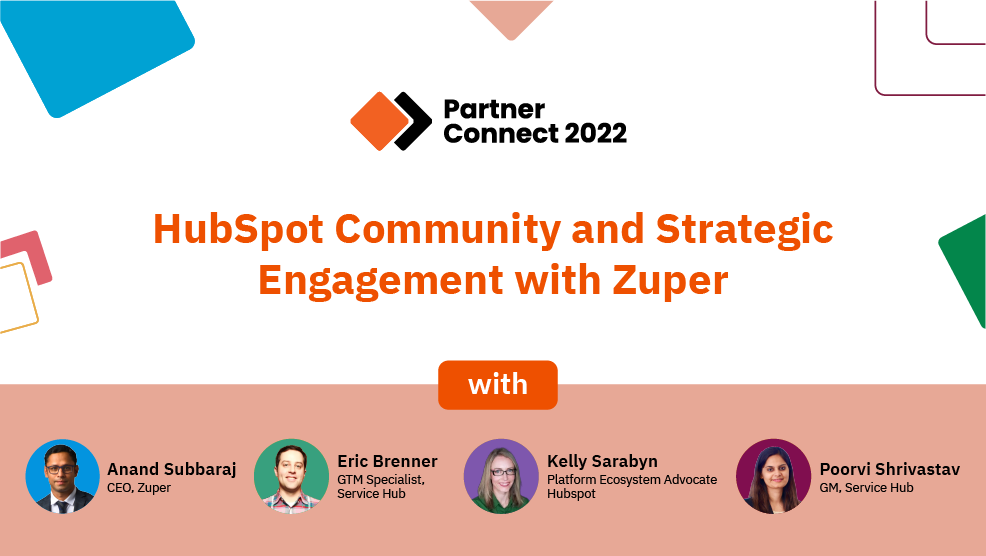Partner Connect 2022 saw a number of industry experts coming together to discuss best practices for digitizing, automating, and optimizing service operations. The Zuper team led a full day of discussions about new developments in field service management and highlighted ways in which the Zuper platform and partnerships empower FSM businesses.
In the session called HubSpot Community and Strategic Engagement with Zuper, Poorvi Shrivastav, Eric Brenner and Kelly Sarabyn of HubSpot as well as Anand Subburaj of Zuper shared insights about the concept of community-led growth and spotlighted the extensive HubSpot partner ecosystem. They also detailed the integration between Zuper and HubSpot.
Poorvi Shrivastav, GM Service Hub
Poorvi Shrivastav supports HubSpot’s Service Hub product offering, which involves customer service.
Eric Brenner, Go-To-Market Specialist Service Hub
Eric Brenner works closely with HubSpot’s product teams and across the company to make sure HubSpot hears from partners and customers to more effectively support them and achieve market penetration.
Kelly Sarabyn, Platform Ecosystem Advocate
Kelly Sarabyn works to grow the company’s partner ecosystem and engage partners so they have a better experience.
Anand Subburaj, Founder and CEO of Zuper
Founder and Chief Executive Officer of Zuper, Anand Subbaraj is a seasoned entrepreneur and product leader empowering service organizations around the world to transform customer experience with intelligent field service management and customer engagement.
What is community-led growth?
Poorvi:
There is product-led growth and sales-led growth. Lately, we’ve been hearing about the concept of community-led growth. It means that to enable the next decade of connected customer growth playbook we all need the right technology and way of thinking about its usage. We believe HubSpot is differentiated and positioned to help with this.
With our connected Commerce-Powered CRM we’ve always been close to both community customers through educational content. For example, we’ve had more than 450,000 growth professionals certified through HubSpot Academy and have more than 10 million visitors to our blogs each month. We are also bringing together the experts and the assets needed by partners into our Network and Marketplace. As a result, we are growing this incredible peer-to-peer community. That is the dream of our connected community.
We are living in a crisis of disconnection, whether it be people, data, or products. The community can help with this – that’s why it matters. We all know the value of community, it’s what motivates us personally. We have a circle of friends, colleagues at work, people we play golf with. a certain set of people. It’s how our personal and professional lives are connected, and it’s how we build businesses and amazing products and services.
Tell us about the key tenants of an ideal community.
There are few key elements to crafting the IDEAL community for someone, one that fosters the most valuable connections.
Identity: to be seen, understood, and valued. The community should not only know the places I’ve worked or the roles I’ve had, but it should also know what I care about, what products I use as an individual, and what I’m looking for in my career. I’m looking to hire, to grow my team’s leadership, and launch new playbooks for expanding our footprint for Service Hub. I also want to improve my skills as a business writer because I want to write a book one day. Those are the things I need and aspire to be. A community can help in each of these aspects. The community itself should have an identity as well and understand the value it adds to its members.
Diversity: Bring together people with common interests but different backgrounds, skills, and experiences. If you are a marketer working for a B2B company in San Francisco, you may want to connect with a B2C marketer in Singapore to chat about WhatsApp or WeChat. If you’re a field technician you might want to connect with an expert in the manufacturing and service industry, let’s say in Europe to learn about possible ways of growing your career internationally. The more diverse a community is, the greater it’s potential for valuable, meaningful connections.
Engagement: the ability for community members to engage with each other. Without deeper engagement, we don’t get substantial growth and outcomes. For example, Anand and I actually met through HubSpot Ventures, and over the last six months, we’ve not only exchanged value and ideas around customer service and field service, but I’ve also learned about the B2B SaaS ecosystem and investment players in India. This is something that I’ve been looking to learn and invest in more for years.
Action: the community needs to provide a way for members to take action. Ideally, there should be a marketplace connected to the community so that you can buy products and services as you discover them.
Learning: The community should help connect the dots between what you need to learn and the people. It should provide content and courses that will help you learn.
What are the HubSpot’s long-term goals and how does connect.com fit into those goals?
Our most important guiding principle is solving for the customer. We want to make sure that our decisions are in alignment with that core principle. To truly solve for the customer we needed to deliver more than just great software. We need great content too. That’s why we invest so much in content as a company. But there’s still one missing piece: community. Community connects us to what we need, the people, products and services that can help us all grow better. We aspire to be a success as a service company. Our mission is to help millions grow better, and we decided to make a significant investment to do that more effectively.
HubSpot connect.com is the connected community for growth professionals, a one-stop shop to connect the dots for advancing your company and your people’s career. In terms of product, connect.com will combine Network, our existing Marketplace, and our existing HubSpot Academy, the core elements of people, product, and learning and bring them together for our millions of users and many more. Thankfully we already have an audience of millions in several communities right now we will be working to turn that audience into a connected community through connect.com.
Here are some examples of where this could go. Imagine using connect to recruit people with verified experience using specific parts of HubSpot like an integration specialist that has configured custom objects in our CRM or a developer that’s been using our APIs for over four years. We have that data. Imagine connecting in HubSpot Academy so you and I can join a study group for any of the courses. Imagine a connect button in our service app so you can have a discussion with other like-minded customers on how to set up your new business process workflows. It’s something we’ve been excited about since the day HubSpot started, and now it’s actually taking shape as a product.
We do dream big with connect.com. It will be the ideal connected community for growth professionals like you and me. We are excited for this community to come together and even more excited to do it with partners like Zuper.
What problems are businesses facing when it comes to using SaaS apps?
Kelly:
Creating HubSpots’ investment in the community connects to our partner ecosystem because our partners are really key to that strategy and key to its success. We have over 7,000 solution partners and over 1100 app partners. Our goal is to have all of these different partners in HubSpot working together successfully.
Let’s take a step back and think about the problem that we’re addressing when it comes to our partner ecosystem. The average company nowadays uses 254 SaaS apps, and even small businesses are using 45 SaaS apps on average. The plus side of that is all these different systems are doing great things. They usually have a particular use case that they’re solving. But unfortunately, this accelerated when we moved into the cloud over the pandemic. These systems are often disconnected and don’t work well together. People have to export data and import data, which creates problems for the business and their customers.
If you imagine a customer service agent trying to track down all the information on a customer they’re trying to help, it ends up causing a lot of disconnection on a personal level between the customer and the agent because these systems are disconnected, and they can’t get the information they need at the time. This is a significant problem in the market and businesses are losing a lot of money because they’re missing opportunities. They’re also putting a lot of money into trying to patch their systems together.
How does HubSpot help with these issues?
At HubSpot, we really see an opportunity here. Businesses know this is a problem, and they’re really looking for systems that are integrated and have strong APIs like HubSpot and Zuper that come connected out of the box. They are also looking for solutions where partners can use the open APIs of those systems to further customize for the business.
HubSpot is a good ecosystem to invest in and partner with. We are definitely committed to the user experience. We’re very customer-centric, something that is shown by our customer size, growth, and our awards. But we’re really committed to having an easy-to-use system that solves that point of disconnection such that the user feels they’re able to access the data they need when they need it without going through a bunch of disparate systems.
We have a wide variety of customers we service – different sizes and verticals. We provide great opportunities to potential partners around their existing customers and also help them expand who they’re servicing. HubSpot has built all these different hubs that facilitate this. You could start using the Service Hub to implement HubSpot and Zuper together and then expand out to the Sales Hub. They have been built on a common data model with one user interface. Therefore, it’s very seamless for the customer.
This is in contrast with other systems that have grown through acquisition and have systems that aren’t yet fully integrated, providing a very disparate, disjointed experience. Our vision is really to have this wide breadth of products but recognizes that, even when there are these different functionalities within the core product, we’re never going to meet all customer needs. That’s where our 1,100 app partners and 7,000 solution partners come in.
Solution partners can look at which integrations can be installed out of the box and then go to the next level to ensure that implementation is smooth and that they can use our APIs to do custom work. We do have a very wide customer base already using those out-of-the-box apps. Additionally, a high percentage of them are using custom APIs to layer on top of this, especially when they have a partner attached to their account.
These 1,100 apps aren’t only coming from the marketing Hub. We have apps like Zuper that have Service Hub and Sales Hub and Ricotta, a kind of iPass that extends across all the hubs. When these apps integrate they put data into all the different hubs because all the hubs are connected seamlessly. This is helpful for a solution partner because they’re going to address a lot of the use cases that they want for customers, and it’s a really effective starting point for that implementation.
What are the specific benefits to becoming a HubSpot partner?
With regards to our partners, over the past three years, we’ve really invested quite heavily in becoming partner-led. 43% of deals are driven by the solution partners, and implementations are typically being performed by our partners instead of by HubSpot. This signals that we trust our partners to be our voice during that implementation period, which is probably one of the most important periods for customers. If you don’t provide a good implementation you’re going to lose a lot of people. Another interesting statistic is that, by 2025, for every dollar that HubSpot makes in revenue selling its software, our partners will be making $6.49. This is an ecosystem that’s rapidly growing, particularly for our partners who are benefiting more and more in proportion to the direct revenue that we’re accruing by selling our software.
We really have put a lot of energy and effort into making sure that partners have a good experience in the program. It’s really easy to join. There are no big upfront fees, and there is a lifetime commission for solution partners. HubSpot is wholly committed to making sure that partners can sell more services. They are a wide variety of services such as digital marketing, implementation, integration work, and operations setup. There’s a really wide breadth of services that you can layer on top of HubSpot.
We’ve invested in our developer experience so you can easily customize or partner with another agency that will customize for you. HubSpot has great API documentation, Postman, client libraries, and a really thriving community of partners and HubSpotters who support each other by answering technical questions. It’s a seamless, hands-on experience. While there’s really incredibly wide breadth of services that can be sold, we also encourage partners in our community to team up to offer end-to-end experiences.
What is Strategic Partner Enablement?
At every stage of the partner journey, we offer benefits to being a partner, but as you invest more we like to make sure we’re giving back. We have Strategic Partner Enablement for our most strategic partners who have decided to fully invest in the HubSpot ecosystem. This is a very hands-on team at your disposal that offers a one-to-one high-touch experience. The same thing goes for our training and resources. These become a more one-on-one experience where you’re really getting the exact training and education you need to be successful.
Additionally, there are other benefits for every stage of the partner journey. Solution or app partners get early access to product insights because you want to design your offerings and understand what’s coming down the pipe so that you’re prepared to implement new product features or do API work in the event of a new API release. We also partner on the go-to-market side. There’s so much opportunity for co-selling and co-marketing with HubSpot and within the community with other solution partners and app partners like Zuper. It is our core belief that when we all work together we’re able to drive more value for ourselves and our partners and also give the customer that unified experience that we’re all looking for these days.
What are customer expectations these days and how does Service Hub address them?
Eric:
88% of customer service professionals agree that customers have higher expectations than they did in the past, 72% of customers expect agents to know who they are and what their previous engagements were, and 70% of customers use self-service channels at some point in their resolution journey. Leaders understand and embrace the fact that customer experience is the competitive edge.
Service Hub comes with all of these features today, with more coming. We give you everything you would need from the help desk and shared inbox with all of the channels and omnichannel functionality from email and chat, Facebook Messenger, and WhatsApp inbound calling. We’ve got a knowledge base and customer portal and service analytics. HubSpot is built on one CRM with all of the tools on top of it, so we really can build out automation and surveys whether it’s the industry standard ones like NPS or CES or Custom Service. We’ve got a lot of great features that allow you to run your service.
Describe the Zuper-HubSpot integration.
The idea here with our Zuper integration is that we want to provide a better customer experience with that best-in-class HubSpot CRM connected with Zuper’s field service. We really target a fast-growing business that leverages field service. It has a ticketing system, a CRM, accounting financing or other business apps in place and is looking for operational efficiency and profitability. It’s the COO, the CTO, the Field Service Leader, or the Sales Owner – really anyone who is going to touch both sales service or that field service side of things.
We want to empower agents to automate field service visits and customer communication and empower field technicians to operate efficiently and offer a world-class customer experience. We’ve already seen this occur with a landscaping company called TRIM Landscaping who report that we’re making it easier for them to recruit landscapers and deliver better overall service. From Sail Internet we’re seeing that, as they grow, we’ve helped them manage their field service operations more effectively.
At this point, HubSpot is built as that CRM where the layout looks the same, but the integration is now even more powerful because you don’t need just Service Hub. You can also schedule some pieces inside of Sales Hub. So you’re getting everything you need in one place: part of your team can be in HubSpot and part of that team can be in Zuper and everyone is still moving forward efficiently.



